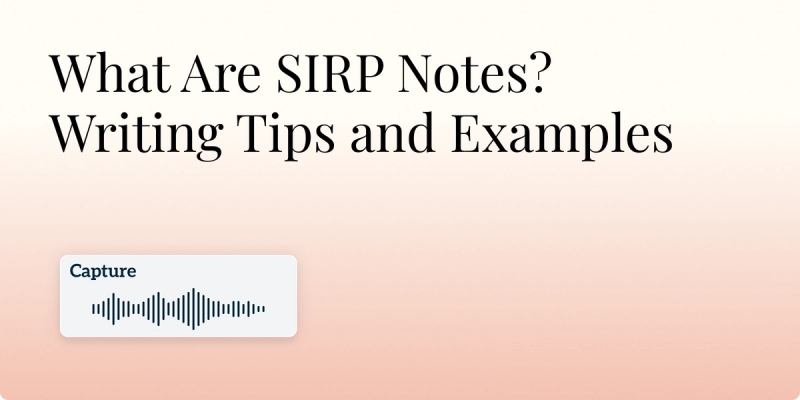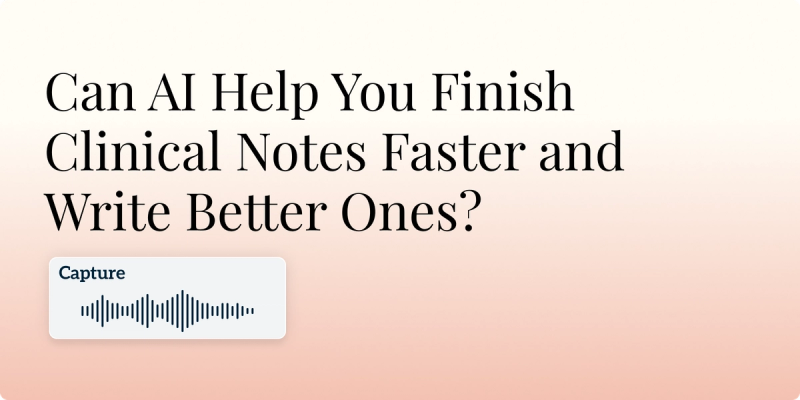
What Are SIRP Notes? Writing Tips and Examples

Accurate, timely SIRP notes (Situation–Intervention–Response–Plan) are one of the fastest ways to turn raw session memories into defensible clinical documentation. They help mental health professionals satisfy HIPAA’s minimum‑necessary standard, meet APA record‑keeping guidelines, and—most importantly—make therapy sessions safer and more goal‑directed for clients .
Below you’ll find a deep‑dive guide that expands every section of the SIRP framework, equips you with numbered workflows, advanced examples, a free SIRP note template, and valuable insights on common pitfalls.
What Are SIRP Notes?
SIRP notes are structured progress notes that capture a client’s situation, the therapist’s interventions, the client’s response, and the follow‑up plan. Compared to other progress notes, SIRP notes strike a balance between narrative context and reimbursement‑ready specifics, making them a favorite for documenting therapy sessions in community mental health, private practice, and integrated care settings.
Why the hype?
- They force clarity around the client’s progress instead of generic session summaries.
- Payers see an explicit chain from clinical problem → therapeutic interventions → measurable outcomes.
- Coordinating providers can quickly locate risk data and next steps without sifting through lengthy prose.
SIRP Note Format: Core Components
1. Situation – Summarizing the Client Experience
Quick definition: A concise, client‑centered snapshot of the presenting concern and context.
Checklist
- Client’s voice – Quote direct statements (e.g., “I felt panicky before the meeting”).
- Contextual triggers – Recent life events, social determinants, and medical changes.
- Risk alerts – Suicidal ideation, self‑harm, violence, substance use.
- Mental‑Status anchors – Affect, speech, orientation, cognition.
- Benchmark metrics – PHQ‑9 = 17, GAD‑7 = 12.
Useful phrases
- “Client reported ___ when ___.”
- “Denies SI/HI but endorses ___.”
- “States goal: ___, rating distress 0–10.”
Common pitfalls
- Over‑documenting historical data is better suited for the intake.
- Omitting risk language (e.g., “no SI/HI”)—a legal vulnerability.
2. Intervention – Documenting Clinical Actions
Quick definition: Everything the clinician did to help during today’s therapy session.
Levels of detail
Clinical Documentation Element | Example |
|---|---|
Therapeutic modality & therapist’s interventions | CBT thought‑record; EMDR Phase 2 |
Delivery method | Telehealth via HIPAA‑compliant Zoom |
Clinical notes on homework | activation |
Administrative actions | Coordinated with psychiatrist about dosage |
Coding tip (U.S.): Tie interventions to CPT codes (e.g., 90834) in your EHR to speed up claims.
Do’s
- Mention any standardized tools (e.g., “Administered PCL‑5”).
- Record treatment modalities used (individual, group, family).
Don’ts
- List interventions that never occurred just to lengthen the note.
- Use jargon without context (“did basic MI”—spell out Motivational Interviewing steps).
Response – Evaluating the Client’s Reactions
Quick definition: How the client actually responded—verbally, behaviorally, physiologically.
Metric‑based options
- Pre/post SUDs (Subjective Units of Distress).
- Heart‑rate or biofeedback readings.
- Shift in suicidal‑ideation rating.
Subjective + Objective Combo
- “Client smiled, shoulders dropped; stated, ‘That reframe makes sense.’”
- “Tearful, voice shaky, but continued exposure word list.”
Why it matters
Payers and auditors treat the response as proof that therapeutic interventions drive the therapeutic process, demonstrating the client’s progress in concrete terms.
4. Plan – Outlining Next Treatment Steps
Quick definition: Homework, referrals, safety tasks, and scheduling—all linked to treatment goals.
SMART‑linking formula
- Specific goal: “Reduce panic attacks from daily to ≤ 1/week.”
- Task/HW: “Log triggers in CBT app twice daily.”
- Owner: Client.
- Timeline: Review 07‑08‑2025.
- Success metric: ≥ 80 % trigger capture rate.
Risk & coordination
- “Parent emailed copy of safety plan.”
- “Referral to dietitian faxed.”
How to Write Effective SIRP Notes: Step-by-Step Guide
- Step 1: Capture raw notes within 5 minutes post‑session. Voice‑to‑text keeps details vivid.
- Step 2: Anchor the Situation with one sentence in the client’s voice plus one observation.
- Step 3: Batch Interventions: Use EHR smart‑phrases—“Conducted psychoeducation: amygdala basic‑science script.”
- Step 4: Document the client’s response immediately to preserve emotional nuance.
- Step 5: Translate into plain language. Avoid “labile affect”; say “mood swung from tears to laughter.”
- Step 6: Align the Plan to at least one treatment plan objective for billing proof.
- Step 7: Run a compliance sweep. Confirm HIPAA‑minimum‑necessary exposure (no family gossip)
- Step 8: Proofread in 90 seconds. Read aloud; if a non‑clinician can grasp it, you’re golden.
- Step 9: Lock the note and timestamp. APA urges contemporaneous entry.
- Step 10: Sync to Twofold to auto‑populate outcomes dashboards.
Advanced Tips for Time‑Efficient Documentation
- Text expanders (e.g., “;sirp”) fill an entire sirp note template in three keystrokes.
- Measurement‑based care: Let your EHR auto‑pull PHQ‑9 scores into the Response field.
- Voice AI: Twofold turns live audio into draft SIRP notes in seconds, preserving the client’s situation and the therapist’s interventions verbatim.
- Split screen with template on the right, session video on the left.
Examples of SIRP Notes in Practice
Example 1: Therapy Session for Anxiety
S: “Heart races at 5 a.m. thinking about layoffs.” PHQ‑9 = 14.
I: 10‑min diaphragmatic breathing; CBT cognitive restructuring; handed free SIRP note template for client journaling.
R: Client’s pulse dropped from 104 → 78; said, “I can do this at home.”
P: Practice breathing 3×/day; schedule exposure hierarchy next session; email progress notes to PCP with consent.
Example 2: Substance‑Recovery Group Session
S: Member shared relapse trigger: family conflict.
I: Motivational Interviewing roll‑with‑resistance + role‑play refusal skills.
R: Reported craving from 6/10 → 3/10; peers offered coping statements.
P: Attend two SMART Recovery meetings; update coping‑card; therapist to review urine screen results.
Example 3: Crisis Intervention for Suicidal Ideation
S: Texted hotline; intent with access to means.
I: Telehealth safety assessment; collaborative safety plan; contacted mobile crisis.
R: Agreed to lethal‑means restriction; hope scale 0 → 4.
P: Voluntary hospitalization; crisis‑team follow‑up within 24 h; document client’s response in EHR risk log.
When to Use SIRP Notes
Scenario | Why SIRP Wins |
|---|---|
One‑on‑One therapy sessions | Keeps focus on current stressor and micro‑changes in the client’s progress. |
Group or Family therapy sessions | Each member’s response is documented, preventing blurred accountability. |
Crisis or brief interventions | Real‑time safety decisions demand the Situation‑Response chain. |
Collaborative documentation in telehealth | Clients watch you write; the structure keeps clinical notes succinct yet transparent. |
Download our SIRP note template (it’s a free SIRP note template—no email gate).
Benefits of Using SIRP Notes
- Clearer progress tracking – The built‑in Response field displays the client’s progress quantitatively and narratively.
- Enhanced care collaboration – Psychiatrists instantly see medication‑side‑effect notes.
- Stronger legal & ethical compliance – Information stays within HIPAA’s minimum‑necessary boundaries .
- Insurance support – Medical‑necessity audits love seeing therapists’ interventions tied to measurable outcomes.
- Time savings – Clinicians using Twofold report 65 % faster documentation while preserving clinical depth.
Common SIRP Note Mistakes to Avoid
Mistake | Why It Hurts | Fix |
|---|---|---|
Writing too much Situation, too little Plan | Leaves reviewers guessing about next steps | Cap Situation at ~120 words; expand Plan with SMART goals |
Ignoring the client’s response | Removes evidence of change | Always include at least one quote + one metric |
Using vague jargon | Payers flag non‑specific phrases | Swap “improved insight” for “identified two new coping strategies” |
Skipping proofreading | Typos can become legal liabilities | Read note aloud before signing |
SIRP Notes vs Other Formats
Note Type | Main Sections | Best For | Limitations |
|---|---|---|---|
SIRP notes | Situation, Intervention, Response, Plan | Holistic yet concise documentation | Requires discipline to keep sections balanced |
Subjective, Objective, Assessment, Plan | Medical settings, med‑management | Less emphasis on client’s response | |
Data, Assessment, Plan | Solo practitioners pressed for time | Minimal narrative context | |
Goal, Intervention, Response, Plan | Goal‑oriented programs | May ignore contextual situation |
For a deeper comparison, see our companion guide on Progress notes.
How Twofold Supports SIRP Notes
Twofold’s AI medical scribe listens during therapy sessions, identifies the client’s situation, transcribes the therapist’s interventions in real time, gauges the client’s response from sentiment cues, and drafts a ready‑to‑sign Plan. Attachments such as PHQ‑9 scores are auto‑embedded, and the final sirp notes export directly into major EHRs—including JSON, FHIR, and PDF. Clinicians also access a KPI dashboard that visualizes the therapeutic process across caseloads, highlighting valuable insights about intervention effectiveness.
Conclusion
Mastering SIRP notes transforms documenting therapy sessions from a time sink into a laser‑focused clinical asset. By rigorously capturing the client’s situation, detailing the therapist’s interventions, recording the client’s response, and crafting a forward‑looking Plan, you create progress notes that satisfy regulators, payers, and—most importantly—push the therapeutic process forward.
Frequently Asked Questions
ABOUT THE AUTHOR
Dr. Danni Steimberg
Licensed Medical Doctor
Reduce burnout,
improve patient care.
Join thousands of clinicians already using AI to become more efficient.

Can AI Help You Finish Clinical Notes Faster and Write Better Ones?
Discover how AI reduces documentation time while improving note quality and clinical detail. See the evidence and techniques

Are AI Scribes Worth It? 2026 Data, ROI Math, Risks & Best Options
Are AI scribes worth it in 2026? See peer‑reviewed results, real costs, HIPAA & risk checks, and a simple ROI calculator - plus who should (and shouldn’t) buy.

Writing Notes With Your Voice: What Actually Works in 2026?
Write clinical notes with your voice in 2026. See how AI scribes turn conversations into structured notes to cut burnout and boost accuracy.

